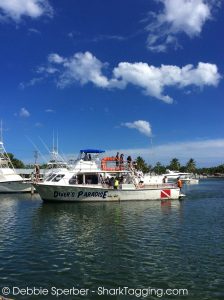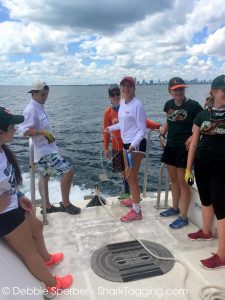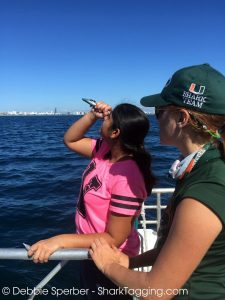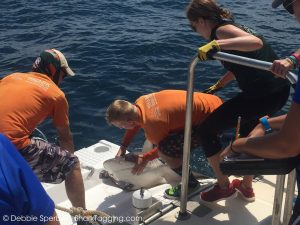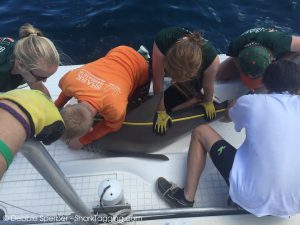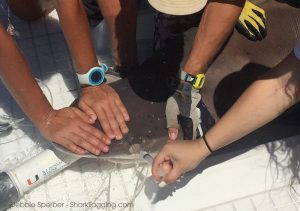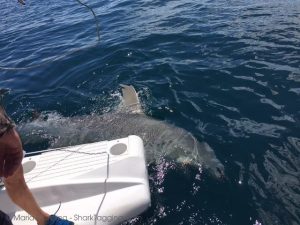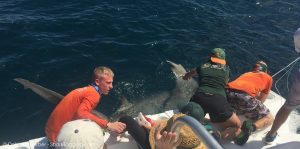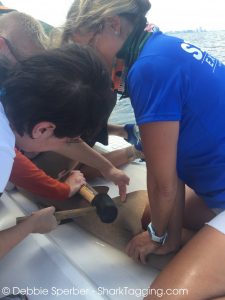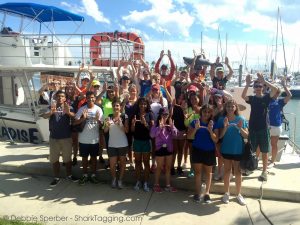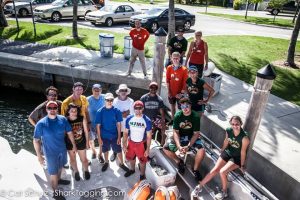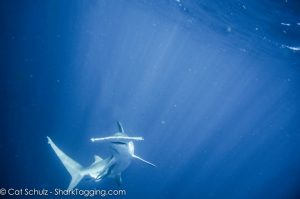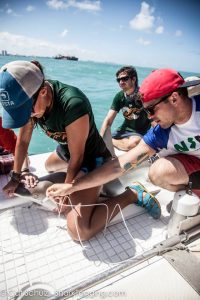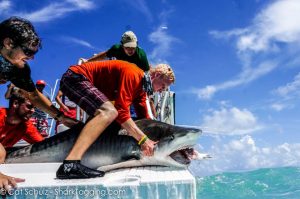Shark Tagging with the Children’s Wish Foundation
By Tim Hogan, SRC Intern
On the morning of Friday, April 8th, a crew of 10 SRC interns and their captain gathered together to prepare for a day of serendipity and many sharks. Our guests, associated with the Children’s Wish Foundation of Canada, came along to meet our team leader, David Shiffman, and get some hands-on experience with the boat and sharks. The volunteer’s enthusiasm and eagerness to learn made them fit right in with the rest of the crew. After preparations were made, the Diver’s Paradise made its way to the Sandbar Palace, a deep reef with high productivity. It had previously been the site of very successful, high-catch trips, and hoped the same would occur on this day.
The second line we pulled up had tension, meaning that something was on the line. As it neared the boat, he was identified as a nurse shark, one of the more commonly caught species. This one, however, was extremely energetic and acrobatic, and began taking various evasive maneuvers, primarily consisting of twirls, flips, and twists. Eventually, he fulfilled his dream of becoming an escape artist, detaching from our line with no damage done to itself. Even though we couldn’t get any data from it, the early shark enhanced our optimism, the anticipation built with each retrieved line.
Our patience was quickly rewarded 5 lines later, as an even larger nurse was brought in with the buoy. This time, we managed to bring it onto the platform, and got the chance to collect our measurements and a blood sample. Our volunteers were eager to get involved and helped with the workup. During the downtime between lines, the volunteers took the opportunity to observe the blood analysis procedure, and also measured water samples.
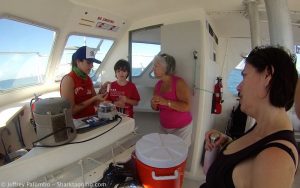
Shark Intern Leila AtallahBenson showing volunteers our blood analysis protocol
As the day progressed, we only seemed to get luckier with each drumline we pulled. On the second line on the third set, we could see the distinct dorsal fin of a great hammerhead approach the boat from the surface. The titan measured up to 328 cm (about 10’9” in the imperial system, which is basically twice my height), and it was released in good condition after our protocol. Less than five lines later, as if we received the blessings from the ocean itself, we brought in a scalloped hammerhead. Distinguished by a more curved head, it is one of the rarest sharks found on trips, and is caught three to five times a year. We went through our protocol quickly and cautiously to ensure it returned to the ocean in the best possible condition.
While we were perfectly content with our first two sets, our final ten lines had us end with a bang. Starting strong, we brought in the namesake of our site, the sandbar shark. The personal favorite of David, he was ecstatic beyond description as we went through our protocol. It was easy to see why, with its faint, iridescent skin and gorgeous color. Two lines later, we managed to pull in the most common shark in South Florida, the Atlantic sharpnose shark. Sharpnoses are typically much smaller out of most of the other species we catch. This one was in particular had a length of 116.5 centimeters, which is almost a meter shorter than the next smallest one.
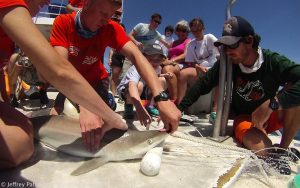
The sharpnose is the most common shark in South Florida, and is also one of the smallest. The pump flows oxygenated water over its gills, ensuring that it can breathe while we do our workup
The remaining time was more calm, though we did manage to bring in another nurse shark. At the end of the day, it was difficult to not appreciate the sheer diversity of sharks. Of the nine sharks we brought in, there were four nurses, two great hammerheads, one sandbar, one sharpnose, and one scalloped hammerhead. Our volunteers were able to see sharks in their many shapes, sizes, and functions. We returned to shore knowing the day was extremely successful, and more than grateful that we got as lucky as we did.
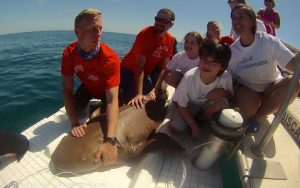
Our volunteers gathered around one of our Nurse Sharks after taking data and measurements, with interns Jake Jerome, team leader David Shiffman, and intern Emily Nelson

